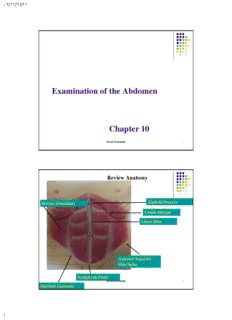
Examination of the Abdomen PDF
Preview Examination of the Abdomen
06/11/1431 Examination of the Abdomen Chapter 10 Ra'eda Almashaqba 1 Review Anatomy Xiphoid Process Rectus Abdominis Costal Margin Linea Alba Anterior Superior Iliac Spine Symphysis Pubis Ra'eda Almashaqba 2 Inguinal Ligament 1 06/11/1431 Ra'eda Almashaqba 3 9 Regions Ra'eda Almashaqba 4 2 06/11/1431 Ra'eda Almashaqba 5 Ra'eda Almashaqba 6 3 06/11/1431 Location! Location! Location! RUQ liver gallbladder duodenum (small intestine) pancreas head right kidney and adrenal Ra'eda Almashaqba 7 Location! Location! Location! RLQ cecum appendix right ovary and tube Ra'eda Almashaqba 8 4 06/11/1431 Location! Location! Location! LLQ sigmoid colon left ovary and tube LUQ stomach spleen pancreas left kidney and adrenal Ra'eda Almashaqba 9 GI Variations Due to Age Aging- should not affect GI function unless associated with a disease process Decreased: salivation, sense of taste, gastric acid secretion, esophageal emptying, liver size, bacterial flora Increased: constipation! Ra'eda Almashaqba 10 5 06/11/1431 Health History Gastrointestinal Disorder Indigestion, N&V, Anorexia, Hematemesis - Ask the pt how is your appetite Indigestion ----- distress associated with eating Heartburn ---- sense of burning or warmth that is retrosternal and may radiate to the neck Excessive gas: frequent belching, distention or flatulence ,Abd fullness. Dysphagia & odynophagia Change in bowel function Constipation or diarrhea Jaundice Ra'eda Almashaqba 11 Abdominal pain: Visceral : Occur in all the abd, burning, aching, difficult to localize, varies in quality e.g. pain in RUQ from liver distention Parietal pain: In parietal peritoneum, caused by inflammation, steady, more sever, localized, increase by movement or coughing Referred pain: felt at more distant site, well localized, Ra'eda Almashaqba 12 6 06/11/1431 Urinary Tract Disorder: Ask about difficulty in passing urine? --- dysuria How often do you go to bathroom?---- frequency Do you have to get up at night ?----- nocturia How often? How much urine do you pass at a time? --- polyuria Do you ever get problem getting to the toilet on time? Do you have any problem in holding urine?- incontinence Do you have any problem in initiating urination? -hesitancy Do you have notice any change in urine color? -- hematuria Assess for kidney or flank pain, uretral pain Ra'eda Almashaqba 13 Bowel Habits Past Abdominal History Medications Aspirin smoking Nutritional Assessment 24 hour recall Nutritional patterns Weight change Exercise patterns Ra'eda Almashaqba 14 7 06/11/1431 Ra'eda Almashaqba 15 Techniques for Exam Provide privacy. Good lighting/appropriate temp room Expose the abdomen. Empty bladder. Position pt supine, arms by side & head on pillow with knees slightly bent or on a pillow. Warm stethoscope & hands. Painful areas last. Distraction techniques. Ra'eda Almashaqba 16 8 06/11/1431 Technique of examination Inspection Start from Rt side, note: Skin( scars, striae, dilated vein, rashes, lesions) -Scars ( describe them, or diagram location) -striae ( pink-purple with Cushing's syndrome) -Coetaneous angiomas (spider nevi) occur with portal hypertension or liver disease -Prominent dilated veins with portal hypertension, liver cirrhosis, or inferior vena cava obstruction Ra'eda Almashaqba 17 Umbilicus: Contour location any inflammation, or bulge) Abnormalities: Everted Sunken Enlarged Bluish color Ra'eda Almashaqba 18 9 06/11/1431 Contour Normally range from flat to rounded Abnormalities include protuberant or scaphoid, bulge in flank area Symmetry Abnormalities: bulges, masses, Hernia (protrusion of abd viscera through abnormal opening in muscle wall) Pulsation or movements( peristalsis) Normally: aortic pulsation and peristalsis movements may be seen in thin persons Abnormalities: Increased pulsation ----- aortic aneurysm Increased peristalsis ----- intestinal obstruction Ra'eda Almashaqba 19 Auscultation Always done before percussion & palpation Use diaphragm of stethoscope Listen lightly Start with RLQ Ra'eda Almashaqba 20 10
Description: